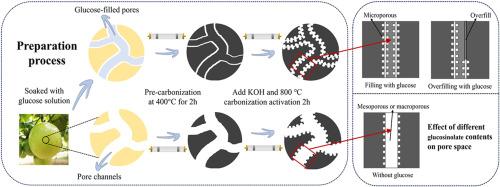Secondary carbon skeletons constructed in porous carbon for electric double layer capacitors
IF 7.1
3区 材料科学
Q1 GREEN & SUSTAINABLE SCIENCE & TECHNOLOGY
引用次数: 0
Abstract
In this work, a secondary skeleton was constructed by filling the larger spaces of porous carbon derived from passion fruit peels with glucose to created more carbon surface in same volume. The combined use of KOH activation and simultaneous etching of micropores on the carbon skeleton and secondary skeleton resulted in the preparation of porous carbon (PGC1-0.5) containing a large number of micropores. PGC1-0.5 have less total pore volume (0.987 cm3 g−1), but more micropore volume (0.821 cm3 g−1), different with 1.171 cm3 g−1, 0.668 cm3 g−1 of PGC1-0, which without glucose. Symmetric supercapacitor bases on PPGC1-0.5 have an obvious improvement in specific capacity (275.6 F g−1 (175 F cm−3), 0.1 A g−1) in 6 M KOH electrolyte compared to PGC1-0 (215.2 F g−1 (121.5 F cm−3), 0.1 A g−1). Additionally, the device exhibits excellent cycling performance and retained 103% of its specific capacity after 10,000 cycles and notable reduction in transfer internal resistance in comparison to the sample without glucose. This study shows that filling space with glucose to reduce macropores is an effective method for adjusting the pore size distribution of porous carbon.

在多孔碳中构建用于双电层电容器的二次碳骨架
在这项工作中,通过用葡萄糖填充从百香果皮中提取的多孔碳的较大空间来构建次骨架,从而在相同体积内形成更多的碳表面。在碳骨架和次骨架上同时使用 KOH 活化和蚀刻微孔,制备出了含有大量微孔的多孔碳(PGC1-0.5)。PGC1-0.5 的总孔隙体积(0.987 cm3 g-1)较小,但微孔体积(0.821 cm3 g-1)较大,与不含葡萄糖的 PGC1-0 的 1.171 cm3 g-1 和 0.668 cm3 g-1 不同。基于 PPGC1-0.5 的对称超级电容器在 6 M KOH 电解液中的比容量(275.6 F g-1 (175 F cm-3), 0.1 A g-1)明显高于 PGC1-0 (215.2 F g-1 (121.5 F cm-3), 0.1 A g-1)。此外,与不含葡萄糖的样品相比,该装置表现出卓越的循环性能,在循环 10,000 次后仍能保持 103% 的比容量,并显著降低了转移内阻。这项研究表明,用葡萄糖填充空间以减少大孔是调整多孔碳孔径分布的一种有效方法。
本文章由计算机程序翻译,如有差异,请以英文原文为准。
求助全文
约1分钟内获得全文
求助全文
来源期刊

Materials Today Sustainability
Multiple-
CiteScore
5.80
自引率
6.40%
发文量
174
审稿时长
32 days
期刊介绍:
Materials Today Sustainability is a multi-disciplinary journal covering all aspects of sustainability through materials science.
With a rapidly increasing population with growing demands, materials science has emerged as a critical discipline toward protecting of the environment and ensuring the long term survival of future generations.
文献相关原料
公司名称
产品信息
阿拉丁
potassium hydroxide (KOH, 99.999%)
阿拉丁
D-(+)-glucose
 求助内容:
求助内容: 应助结果提醒方式:
应助结果提醒方式:


